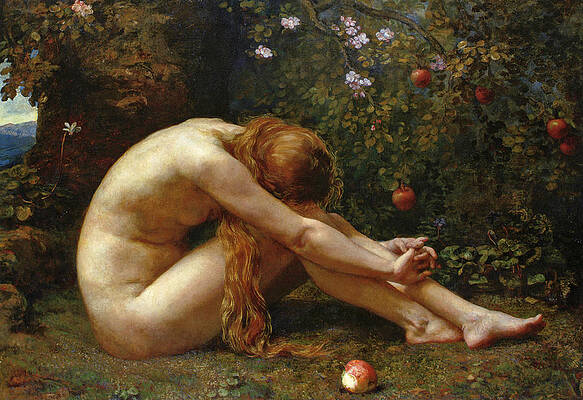Paintings
Anna Lea Merritt (1844–1930) was an American painter. She painted portraits, landscapes and religious scenes. She was born in Philadelphia but lived and worked in England for most of her life.[1] Merritt worked as a professional artist for most of her adult life, 'living by her brush' before her brief marriage to Henry Merritt and after his death.[2]
Early life and training
While well educated in the classics, Merritt received little formal art education as a child and young adult. As women were generally excluded from art academies at the time, she instead practiced art on her own, and later studied anatomy at the Woman's Medical College of Pennsylvania. In 1865, when Merritt was in her early twenties, her father moved the family to Europe where her art was critiqued by Stefano Ussi and Heinrich Hoffman. When she was living in London in 1870, Meritt met Henry Merritt, who would become her tutor and later, her husband.
Love Locked Out

Love Locked Out a nude figure stands with her back to the viewer, leaning against a closed door.
Love Locked Out, Merritt's best known painting.
Merritt painted her best-known work, Love Locked Out, in memory of her late husband, who died in 1877 just three months after their wedding. She had hoped to have the image done in bronze as a monument, but could not afford it. Merritt initially resisted allowing the painting to be copied despite innumerable” requests, because she feared the subject would be misinterpreted: “I feared people liked it as a symbol of forbidden love,” she wrote in her memoir, “while my Love was waiting for the door of death to open and the reunion of the lonely pair”. Though Merrit was already a recognized working artist, she had intended to end her professional career after her wedding, but she returned to painting after his death.[2] Ironically, though she was American, Love Locked Out was exhibited at the Royal Academy in 1890 and became the first painting by a woman artist acquired for the British national collection through the Chantrey Bequest.[3]
Thoughts on women in the arts
Portrait of her husband, 1877
In 1900, Merritt wrote that she felt she had not faced much if any discrimination because of her gender, but noted the social pressures which could inhibit a female artist's career, concluding:
“The chief obstacle to a woman's success is that she can never have a wife. Just reflect what a wife does for an artist: Darns the stockings; keeps his house; writes his letters; visits for his benefit; wards off intruders; is personally suggestive of beautiful pictures; always an encouraging and partial critic. It is exceedingly difficult to be an artist without this time-saving help. A husband would be quite useless."[4]
During the 19th century there were a significant number of women who became successful, educated artists, a rarity before that time, except for a few like Angelica Kauffman and Louise Élisabeth Vigée Le Brun (1755-1842).[5] The emerging women artists created works with a different perspective than men, challenged the limited concepts of femininity and created a genre of floral-female paintings, in which "the artist placed one woman or more in a flower garden setting and manipulated composition, color, texture and form to make the women look as much like flowers as possible.” The approach was not used for portraits. Its form of feminine representation has largely gone unrecognized by American art scholars and conservative society ignored in response to the burgeoning “New Woman” beginning in the late 19th century.[6] Merritt created flower-feminine paintings, noting floral-feminine symbolism employed by male artists like Charles Courtney Curran and Robert Reid, she said that she saw "flowers as 'great ladies' noting that 'theirs is the langour of high breeding, and the repose and calm of weary idleness.”[7]
References
Gorokhoff, Galina (June 1983). "Anna Lea Merritt, expatriate American painter". Antiques: 1221–1227.
Rubinstein, Charlotte Streifer (1982). American Women Artists: From the Early Indian Times to the Present. G.K. Hall. ISBN 978-0-8161-8535-1.
Clarke, Meaghan E. (2004). "Merritt, Anna Massey Lea (1844–1930)". Oxford Dictionary of National Biography (online ed.). Oxford University Press. doi:10.1093/ref:odnb/63111. (Subscription or UK public library membership required.)
Merritt, Anna Lea (1900). "A letter to artists, especially women artists.". Lippincott's Monthly Magazine (65): 463–469. Retrieved 2013-10-25.
Annette Stott. "Floral Femininity: A Pictorial Definition". American Art. The University of Chicago Press. 6: 2 (Spring, 1992). p. 75.
Annette Stott. "Floral Femininity: A Pictorial Definition". American Art. The University of Chicago Press. 6: 2 (Spring, 1992). p. 61.
Annette Stott. "Floral Femininity: A Pictorial Definition". American Art. The University of Chicago Press. 6: 2 (Spring, 1992). p. 62.
18 Paintings by Anna Lea Merritt at the Art UK site
External links
Anna Lea Merritt at the National Museum of Women in the Arts website
Anna Lea Merritt in the Smithsonian Institution Libraries database
----
Fine Art Prints | Greeting Cards | Phone Cases | Lifestyle | Face Masks | Men's , Women' Apparel | Home Decor | jigsaw puzzles | Notebooks | Tapestries | ...
----
Artist
A - B - C - D - E - F - G - H - I - J - K - L - M -
N - O - P - Q - R - S - T - U - V - W - X - Y - Z
Retrieved from "http://en.wikipedia.org/"
All text is available under the terms of the GNU Free Documentation License




